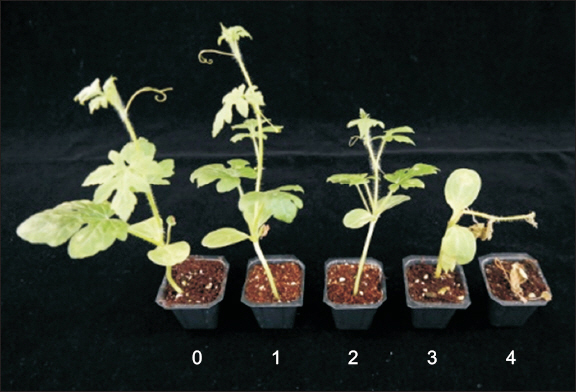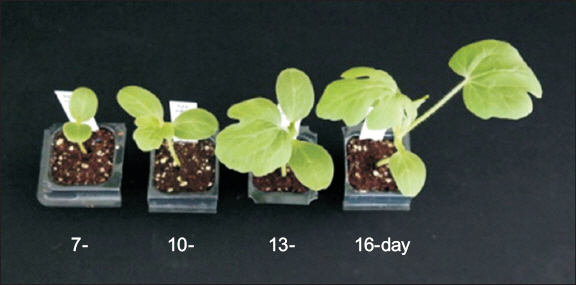ņä£ļĪĀ
ņ×¼ļŻī ļ░Å ļ░®ļ▓Ģ
ņłśļ░Ģ ņ×¼ļ░░
ņĀæņóģņøÉ ņżĆļ╣ä
ņłśļ░Ģ ļŹ®ĻĄ┤ņ¬╝Ļ╣Ćļ│æĻĘĀ ņĀæņóģ
ļ░£ļ│æ ļ░Å ļ│æ ņĪ░ņé¼
Fig.┬Ā2

Ļ▓░Ļ│╝ ļ░Å Ļ│Āņ░░
ņĀæņóģ ļ░®ļ▓ĢņŚÉ ļö░ļźĖ ļŹ®ĻĄ┤ņ¬╝Ļ╣Ćļ│æ ļ░£ņāØņØś ņ░©ņØ┤
Table┬Ā1
| Inoculation method | Inoculum concentration (conidia/ml) | Cultivar | |||
|---|---|---|---|---|---|
|
|
|||||
| Bulrojangsaeng | Soknoranggul | Seotaja | Jijonggul | ||
| Root-dippingŌĆĀ | 1.0├Ś106 | 0.0┬▒0.0ŌĆĪ a┬¦ | 2.3┬▒1.3 a | 3.5┬▒0.7 a | 3.7┬▒0.5 a |
| 1.0├Ś107 | 0.0┬▒0.0 a | 2.5┬▒1.3 a | 3.8┬▒0.6 a | 3.8┬▒0.4 a | |
| Scalpel|| | 1.0├Ś106 | 0.0┬▒0.0 a | 2.0┬▒1.5 a | 3.3┬▒1.2 a | 3.4┬▒1.0 a |
| 1.0├Ś107 | 0.0┬▒0.0 a | 2.4┬▒1.2 a | 3.8┬▒0.4 a | 3.9┬▒0.3 a | |
| Tip┬Č | 1.0├Ś106 | 0.0┬▒0.0 a | 2.2┬▒1.3 a | 3.5┬▒0.7 a | 3.4┬▒1.1 a |
| 1.0├Ś107 | 0.0┬▒0.0 a | 2.1┬▒1.4 a | 3.7┬▒0.9 a | 3.4┬▒1.1 a | |
| Soil-drenching** | 1.0├Ś106 | 0.1┬▒0.3 a | 0.3┬▒0.5 b | 0.8┬▒1.0 b | 0.7┬▒1.3 b |
| 1.0├Ś107 | 0.0┬▒0.0 a | 1.0┬▒1.2 a | 1.4┬▒1.5 b | 1.9┬▒1.9 a | |
* Ten-day-old seedlings of three watermelon (Soknoranggul, Seotaja, Jijonggul) and one watermelon-rootstock (Bulrojangsaeng) cultivars were inoculated with Fusarium oxysporum f. sp. niveum (Fon) HA. The inoculated plants were incubated in a dew chamber at 25┬░C for 24 h and then transferred to a growth room at 25┬░C with 12-h light a day. After 4 weeks, disease severity of the seedling was investigated on a scale of 0-4.
ŌĆĀ Seedlings of each cultivar were uprooted and the roots were washed gently in water. The plant roots were inoculated with two different spore concentration (1.0├Ś106 conidia/ml and 1.0├Ś107 conidia/ml) of Fon HA by which the roots were dipped in spore suspensions for 30 min. The infected plants were transplanted into 40-cell plastic trays.
ŌĆĪ Each value represents the mean of disease index┬▒standard deviation of two runs with ten replicates each.
┬¦ Values in the labeled with the same letter within columns are not significantly different in DuncanŌĆÖs multiple range test at P=0.05.
|| Seedlings were inoculated with Fon HA by cutting the roots with a scalpel, and then 10 ml of spore suspension was applied to soil.
ņāØņ£Īņŗ£ĻĖ░ņŚÉ ļö░ļźĖ ĒÆłņóģĻ░ä ļ│æļ░£ņāØņØś ņ░©ņØ┤
Table┬Ā2
| ŌĆāŌĆāCultivar | Plant growth stage | |||||||
|---|---|---|---|---|---|---|---|---|
|
|
||||||||
| 7-day-old | 10-day-old | 13-day-old | 16-day-old | |||||
| BulrojangsaengŌĆā | ŌĆā0.0┬▒0.0ŌĆĀ bŌĆĪŌĆā | R┬¦ | ŌĆā0.0┬▒0.0 cŌĆā | R | ŌĆā0.0┬▒0.0 cŌĆā | R | 0.0┬▒0.0 c | R |
| Soknoranggul | 2.5┬▒1.2 a | MR | 2.2┬▒1.0 b | MR | 2.1┬▒1.2 b | MR | ŌĆā2.0┬▒0.7 bŌĆā | MR |
| Seotaja | 3.3┬▒0.9 a | S | 3.9┬▒0.3 a | S | 3.5┬▒0.8 a | S | 3.3┬▒0.9 a | S |
| Jijonggul | 3.7┬▒0.7 a | S | 3.8┬▒0.6 a | S | 3.9┬▒0.3 a | S | 3.5┬▒0.8 a | S |
* Seven-, ten-, thirteen-, sixteen-day-old seedlings of three watermelon (Soknoranggul, Seotaja, Jijonggul) and one watermelon-rootstock (Bulrojangsaeng) cultivars were inoculated with Fusarium oxysporum f. sp. niveum HA by cutting the roots with a scalpel, and then 10 ml of spore suspension (3.0├Ś106 conidia/ml) was applied to soil. The inoculated plants were incubated in a dew chamber at 25┬░C for 24 h and then transferred to a growth room at 25┬░C with 12-h light a day. After 4 weeks, disease severity of the seedling was investigated on a scale of 0-4.
ŌĆĀ Each value represents the mean of disease index┬▒standard deviation of two runs with ten replicates each.
ņ×¼ļ░░ ņś©ļÅäņŚÉ ļö░ļźĖ ĒÆłņóģĻ░ä ļ│æļ░£ņāØņØś ņ░©ņØ┤
Table┬Ā3
| ŌĆāŌĆāCultivar | Incubation temperature | |||
|---|---|---|---|---|
|
|
||||
| 25┬░C | 30┬░C | |||
| BulrojangsaengŌĆā | ŌĆā0.1┬▒0.3ŌĆĀ cŌĆĪŌĆā | ŌĆāR┬¦ŌĆā | ŌĆā0.0┬▒0.0 bŌĆā | ŌĆāRŌĆā |
| Soknoranggul | 2.0┬▒0.9 b | MR | 2.7┬▒1.3 a | S |
| Seotaja | 4.0┬▒0.0 a | S | 3.6┬▒1.0 a | S |
| Jijonggul | 3.7┬▒0.7 a | S | 3.5┬▒1.0 a | S |
* Ten-day-old seedlings of three watermelon (Soknoranggul, Seotaja, Jijonggul) and one watermelon-rootstock (Bulrojangsaeng) cultivars were inoculated with Fusarium oxysporum f. sp. niveum HA by cutting the roots with a scalpel, and then 10 ml of spore suspension (3.0├Ś106 conidia/ml) was applied to soil. The inoculated plants were incubated in dew chambers at 25┬░C and 30┬░C for 24 h and then transferred to growth rooms at 25┬░C and 30┬░C with 12-h light a day, respectively. After 4 weeks, disease severity of the seedling was investigated on a scale of 0-4.
ŌĆĀ Each value represents the mean of disease index┬▒standard deviation of two runs with ten replicates each.
ņĀæņóģņøÉ ļåŹļÅäņŚÉ ļö░ļźĖ ĒÆłņóģĻ░ä ļ│æļ░£ņāØņØś ņ░©ņØ┤
Table┬Ā4
| ŌĆāŌĆāCultivar | Inoculum concentration (conidia/ml) | |||||||
|---|---|---|---|---|---|---|---|---|
|
|
||||||||
| 3.7 ├Ś 105 | 1.1 ├Ś 106 | 3.3 ├Ś 106 | 1.0 ├Ś 107 | |||||
| BulrojangsaengŌĆā | ŌĆā0.0┬▒0.0ŌĆĀ cŌĆĪŌĆā | R┬¦ | ŌĆā0.0┬▒0.0 cŌĆā | R | ŌĆā0.0┬▒0.0 cŌĆā | R | ŌĆā0.0┬▒0.0 cŌĆā | R |
| Soknoranggul | 1.5┬▒0.8 b | MR | 1.7┬▒0.8 b | MR | 1.9┬▒1.0 b | MR | 2.2┬▒1.2 b | MR |
| Seotaja | 2.8┬▒1.1 ab | S | 3.7┬▒0.5 a | S | 3.6┬▒0.7 a | S | 3.7┬▒0.7 a | S |
| Jijonggul | 3.1┬▒1.0 a | S | 3.7┬▒0.7 a | S | 3.7┬▒0.9 a | S | 4.0┬▒0.0 a | S |
* Ten-day-old seedlings of three watermelon (Soknoranggul, Seotaja, Jijonggul) and one watermelon-rootstock (Bulrojangsaeng) cultivars were inoculated with Fusarium oxysporum f. sp. niveum HA by cutting the roots with a scalpel, and then 10 ml of each spore suspension was applied to soil. The inoculated plants were incubated in a dew chamber at 25┬░C for 24 h and then transferred to a growth room at 25┬░C with 12-h light a day. After 4 weeks, disease severity of the seedling was investigated on a scale of 0-4.
ŌĆĀ Each value represents the mean of disease index┬▒standard deviation of two runs with ten replicates each.
Scalpel ņĀæņóģļ▓ĢņŚÉ ņØśĒĢ£ ņŗ£ĒīÉ ĒÆłņóģļōżņØś ņĀĆĒĢŁņä▒
Table┬Ā5
| ŌĆāŌĆāCultivar | Inoculation method | |||
|---|---|---|---|---|
|
|
||||
| ScalpelŌĆĀ | Root-dippingŌĆĪ | |||
| Bulrojangsaeng (rootstock)ŌĆā | ŌĆā0.0┬▒0.0┬¦ŌĆā | ŌĆāR||ŌĆā | ŌĆā0.0┬▒0.0 | ŌĆāRŌĆā |
| ShinFR-bulsajo (rootstock) | 0.0┬▒0.0 | R | 0.0┬▒0.0 | R |
| Soknoranggul | 2.0┬▒1.2 | MR | 2.5┬▒1.3 | MR |
| Seolgang102 | 3.5┬▒1.1 | S | 3.9┬▒0.3 | S |
| Hwanggeumggul | 3.3┬▒1.2 | S | 3.8┬▒0.4 | S |
| Bestggul | 3.6┬▒0.7 | S | 3.5┬▒0.5 | S |
| Noranbusibok | 3.3┬▒1.1 | S | 3.7┬▒0.7 | S |
| Jangchunggul | 4.0┬▒0.0 | S | 3.8┬▒0.4 | S |
| Super grand prix | 3.8┬▒0.6 | S | 3.5┬▒0.8 | S |
| Jijonggul | 4.0┬▒0.0 | S | 3.5┬▒0.8 | S |
| Chilbokggul | 3.8┬▒0.6 | S | 3.8┬▒0.4 | S |
| Supergold | 3.5┬▒0.8 | S | 3.4┬▒0.8 | S |
| Busibok | 4.0┬▒0.0 | S | 4.0┬▒0.0 | S |
| Seotaja | 3.5┬▒1.1 | S | 3.6┬▒0.5 | S |
| Noranbok | 3.6┬▒0.7 | S | 3.6┬▒0.5 | S |
| Wellbing | 3.9┬▒0.3 | S | 3.5┬▒0.5 | S |
| Kokoma | 3.9┬▒0.3 | S | 3.5┬▒0.5 | S |
| Nakdonggul | 3.7┬▒0.9 | S | 3.9┬▒0.3 | S |
| Wonderfulggul | 3.8┬▒0.4 | S | 3.9┬▒0.3 | S |
| Bravoggul | 3.6┬▒0.8 | S | 4.0┬▒0.0 | S |
| Heukho | 3.7┬▒0.9 | S | 3.8┬▒0.4 | S |
| Kamchunggul | 4.0┬▒0.0 | S | 3.8┬▒0.4 | S |
| Nunettineggul | 4.0┬▒0.0 | S | 3.9┬▒0.3 | S |
* Ten-day-old seedlings of each cultivar were inoculated with Fon HA. The inoculated plants were incubated in a dew chamber at 25┬░C for 24 h and then transferred to a growth room at 25┬░C with 12-h light a day. After 4 weeks, disease severity of the seedling was investigated on a scale of 0-4.
ŌĆĀ Seedlings of each cultivar were inoculated with Fon HA by cutting the roots with a scalpel, and then 10 ml of spore suspension (3.0├Ś106 conidia/ml) was applied to soil.
ŌĆĪ Seedlings of each cultivar were uprooted, and the roots were washed gently in water. The plants were inoculated by dipping the roots in the spore suspension (3.0├Ś106 conidia/ml) of Fon HA for 30 min and then transplanted into 40-cell plastic trays.




 PDF Links
PDF Links PubReader
PubReader Full text via DOI
Full text via DOI Download Citation
Download Citation Print
Print






